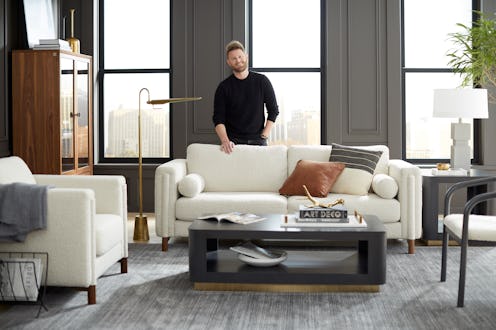Life
'Queer Eye' Star Bobby Berk Tells Us How To Decorate A Space So You Don't Totally Hate It Later

While Karamo can make us cry, Tan can make us French tuck, Jonathan can make us laugh, and Antoni can make us crave avocados, no Queer Eye guy makes us feel the urge to redecorate our homes with dark cabinets and light countertops stronger than Bobby Berk. To put it simply, his home designs are goals, and we now have full access to the streamlined beauty and minimalist aesthetic of his brain with the launch of his new eponymous lifestyle website. So if you've been wondering how the hell he makes things look so stunningly modern in such a short amount of time, we are one step closer to finding out.
Not only does it feature the ins and outs to all his designs, Bobby's new website gives tips on his latest style, food, fitness, and wellness obsessions. There are even organization tips, and guides to filling your pantry with all the essentials to cook a quick meal. It's basically Bobby Berk living 101, and we are here for it.
Bustle chatted with Bobby to learn more about all the design tips he features on his site, and it turns out, he's caught the KonMari bug too. When asked how to be more intentional about what you buy, so you don't wind up throwing it out a year later, Bobby says to make like Marie.
"I think for me, it's about buying things that you really love and not things that are on trend," Berk tells Bustle. "You know, because that's how you get stuff that you end up throwing out because it doesn't spark joy. If it's something that you really love, it doesn't matter if it's not on trend. If it's what you love, you're going to be happy when you see it and you're going to keep it."
So while bright, velvet couches may be all the rage right now, consider whether you may want a bold, millennial pink piece hanging out in your living room a few years down the line. Maybe it truly does spark joy for you now, but if you're having difficulty finding pieces that have staying power, Bobby has a tip for that too.
"I love going to thrift stores and finding great stuff, especially right now because of Marie Kondo," Berk says. "It's a phenomenon right now. Thrift stores, out of the closets, they have more stuff than they know what to do with because so many people are cleaning out their closets and the stuff in their houses [...] So now is a great time to go thrifting and fill your house back up again."
Bobby says if you're worried about these thrifted items feeling cohesive, don't be. If you're looking to blend the things you already have with the new things you know you will love for a long time, Bobby's suggests picking a story that can connect everything, and make it look like it belongs together.
"I try to at least have there be some type of cohesive story, so maybe a color story or a type of things story," Berk says. "I mean some people like eclectic, and eclectic is fine. But I prefer if I was going to get a bunch of random little statues that didn't go together, I paint them all one color. Because that way they're all different, but it's the same color story."
Finally, if you want to keep the throwing things away to a minimum, Bobby says it's important to consider the types of materials you're buying, and whether they are suited for the climate you live in. If you live in New York, for example, you may want to avoid solid wood because of the constant fluctuations in temperature.
"The dry heat [from radiators in the winter] causes your dining table to split down the middle because all the moisture comes out of it [...] So when in New York, MDF [medium-density fiberboard] is actually better."
If you're not sure how a material will react with the climate you live in, Bobby says to take it out of the packaging and let it breathe before setting it up. This way, you can get a feel for whether or not it will last in your home.
While decorating your space can be overwhelming, and you likely won't have the Fab 5's guidance, you don't have to worry too much. By being intentional about what you buy for your home now, you're less likely to have to start the process all over again in the future.